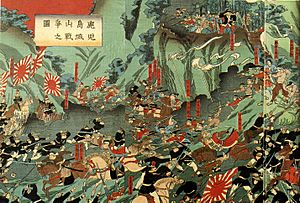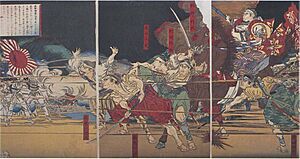Battle of Shiroyama facts for kids
The Battle of Shiroyama (城山の戦い, Shiroyama no tatakai) was the very last fight of a big conflict called the Satsuma Rebellion. It happened on September 24, 1877, in a place called Kagoshima, Japan. In this battle, the rebel army, led by Saigō Takamori, fought against the much larger Imperial Japanese Army. The battle ended with Saigō Takamori's death and the complete defeat of his army. This event marked the end of the Satsuma Rebellion.
Contents
What Was the Satsuma Rebellion?
The Satsuma Rebellion was a revolt by unhappy samurai against the new Japanese government. After Japan opened up to the world, the government decided to make many changes. They wanted to create a modern army and navy, like those in Western countries. This meant that the samurai, who were traditional warriors, lost their special status and privileges. Many samurai were not happy about these changes.
Why Did the Rebellion Start?
The samurai felt that the new government was taking away their way of life. They were no longer allowed to carry swords in public, and their special payments were stopped. Saigō Takamori was a respected leader who had helped bring about the new government. However, he disagreed with some of its policies. He believed the government was moving too fast and forgetting important Japanese traditions. Because of these disagreements, he became the leader of the samurai who rebelled.
Who Was Saigō Takamori?
Saigō Takamori was a very important figure in Japanese history. He was a samurai from the Satsuma region. At first, he was a key leader in the movement that brought down the old feudal government (the Shogunate) and restored the Emperor to power. He was seen as a hero by many. However, as the new government made changes, Saigō became worried. He felt the government was becoming too Western and losing its Japanese spirit. This led him to lead the Satsuma Rebellion.
The Final Battle at Shiroyama
By September 1877, Saigō Takamori and his remaining samurai were surrounded. They had been pushed back to Shiroyama, a small hill near Kagoshima. The Imperial Japanese Army, which was much bigger and had modern weapons, had them trapped.
The Imperial Army's Plan
The Imperial Army had over 30,000 soldiers. They built strong defenses around Shiroyama. They dug trenches and set up many cannons. Their plan was to completely surround Saigō's forces and then attack from all sides. They wanted to make sure no one could escape.
The Last Stand
Saigō Takamori had only about 400 samurai left. They were tired and had very few supplies. On the night of September 23, the Imperial Army began to bombard Shiroyama with cannons. The attack lasted all night. Early in the morning of September 24, the Imperial Army launched their final assault. Saigō and his men fought bravely, but they were heavily outnumbered.
As the battle continued, Saigō Takamori was badly wounded. According to tradition, he asked one of his loyal followers to help him perform a ritual suicide (seppuku) to die with honor. With his death, the remaining samurai fought to the last man. The Battle of Shiroyama marked the end of the Satsuma Rebellion.
Why Was This Battle Important?
The Battle of Shiroyama was very important for Japan. It was the last major armed conflict by samurai against the new government. With the defeat of the Satsuma Rebellion, the government's power was firmly established. It meant that the old samurai class was truly gone, and Japan could continue its path to becoming a modern nation. This battle showed that traditional warrior ways were replaced by a modern, conscript army.
Images for kids
See also
 In Spanish: Batalla de Shiroyama para niños
In Spanish: Batalla de Shiroyama para niños




